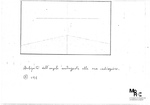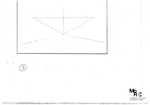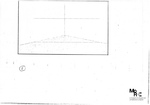Ambiguità dell’angolo
Title
Description
Five projects of environmental intervention in a interior space, formed by two walls ending in a corner and a floor, named from A to E.
The first one, A, is dated 1978 and accompanied by the autograph and handwritten note of the artist: “Ambiguità dell’angolo contrapposta alla sua indicazione” [Ambiguity of the corner opposite to its indication] is a graphic reproduction of a parietal corner on which is drawn, joining the two walls, a straight line of dots. On the floor is drawn straight line of dots converging in the corner itself.
The second, named B, consists of a graphic reproduction of a parietal corner, the two walls joined by a dotted passage of rectangular shape, open and not dotted on the base that ideally stays on the floor.
The third, named C, consists of a graphic reproduction of a parietal corner, the two walls joined by a dotted rectangular shape whose base rests on the floor.
The fourth, named D, consists in a graphical representation of a parietal corner, the two walls joined by a dotted triangle, with the base that joins horizontally the walls, and vertex which coincides with the corner in the meeting point between the two walls and the floor.
The fifth, named E, consists of a graphic duplication of a double dotted parallel line that crosses the two walls and perpendicularly the corner of the environment.
Through the use of a projector, the artist would have reproduced the pattern formed from points in succession using likely graphite. The dotted drawings deny the environmental depth and build illusively another perceptual space, a new environmental perspective.
The project Ambiguità dell’angolo [Ambiguity of the Corner] critically analyses the real space and its theoretical conceiving through the perceptive operation, thus witnessing the enviromental vocation of the entire research by Scaccabarozzi.
In 1986 was held a partial realization of the project for the exhibition “Die Ecke=the corner=le coin”, at Galerie Hoffmann, Friedberg, and in 1988 at Wallis Kantonsmuseum, Sitten, Switzerland. There, Scaccabarozzi tries to represent the direct intervention in the space, using pictorial dots on a corner of the room, and publishing on the catalog six different projects of enviromental intervention, called Ambiguità dell’angolo [Ambiguity of the Corner], and dated 1978.Only the first one of those published, has been realized by the artist in the gallery and consisted in a simple horizontal line of dots, that crossed the corner and reached the two walls, proceeding in parallel with the floor.
The other projects, united in the book of unrealised projects by the artist, had more tecnical difficult for their realization, and they have never been realized.
Recently, for the recent two-men show at Galerie Hoffmann in Friedberg, and dedicated to Scaccabarozzi and Gary Woodley in july-september 2016, Anastasia Rouchota, heir of the artist and founder and director of the Scaccabarozzi archive, reproduced in a room only the project already made in 1986.
Coming back to this historical exhibition, and coherently with the exhibition program of the gallery, among the invited artists were the protagonist of the North and East European neo-concretist and conceptual: Getulio Alviani, Gianni Colombo, Maurizio Nannucci and Antonio Scaccabarozzi from Italy, François Morellet from France, Klaus Staudt and Ludwig Wilding from Germany, Julije Knifer from Yugoslavia, and Herman De Vries from Netherland.
The catalog plays, also graphically, wuith the exhibition topics, containing handwritten texts, sketches and conceptual drawings. In her text, Verena Auffermann starts quoting the Philosophische Bemerkungen by Ludwig Wittgensteinand, and through the philosophical lens of the XIX century, from Artur C. Danto, Richard Serra to Gertrude Stein, she reflects on the relation between space and thought of space, retracing the function and the projectual and metaphoric meaning of the corner in the painting of the last century, starting from Cézanne and Malevich for introducing the 109 artists of the exhibition in 1986.
“The corner
Separates outside from inside
The corner
is dimensional
The corner
defines limits
The corner
Is a man-made design
The corner
Is a closure
The corner
Separates itself from the ‘out-there’
The corner
Is essential to a triangle
The corner
Is the corset for spatial thinking
The corner
Is an ideal playground for optical illusion”.
(Die Ecke = the corner = le coin 1986, s.p.)
Creator
Date
Contributor
Relation
Format
Language
Type
Rights Holder
Collection
Citation
Social Bookmarking
Item Relations
This item has no relations.





